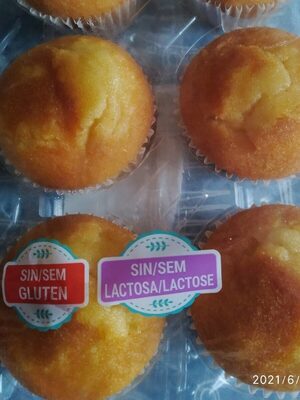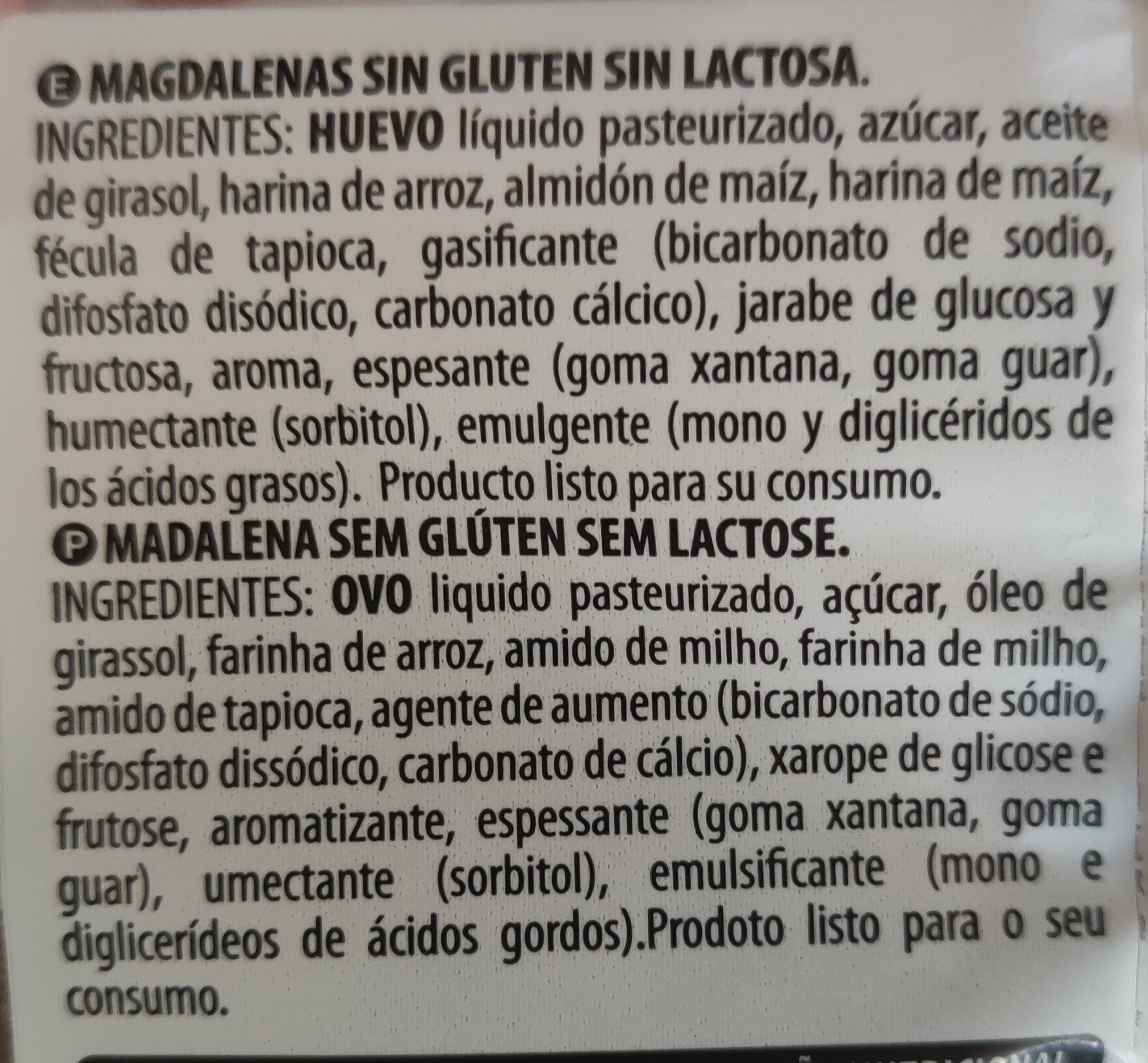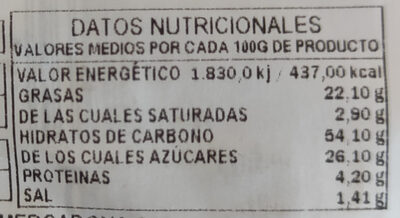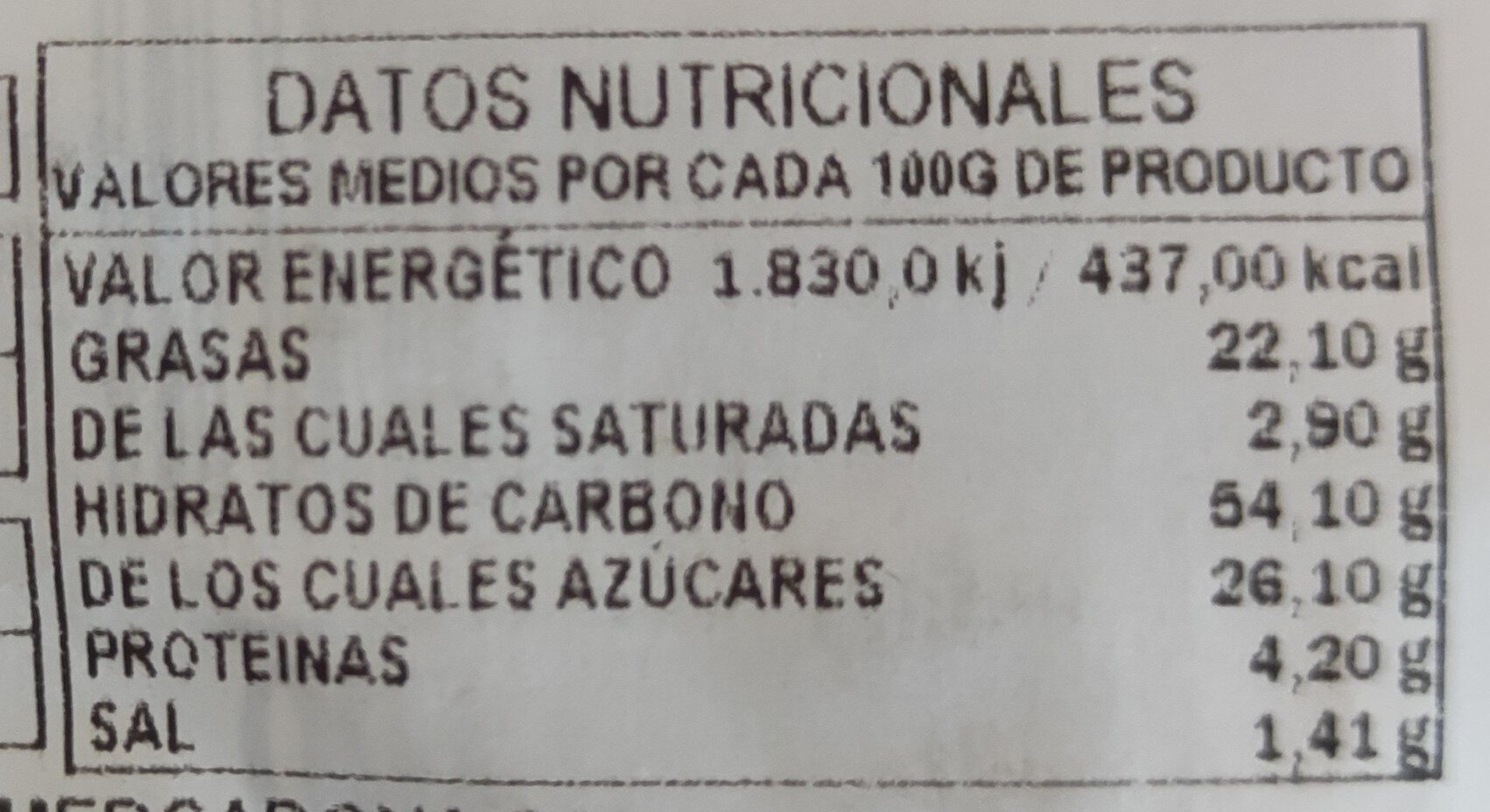Ajuda'ns a fer que la transparència alimentària sigui la norma!
Com a organització sense ànim de lucre, depenem de les vostres donacions per continuar informant els consumidors de tot el món sobre tot allò què mengen.
La revolució alimentària comença amb tu!
Madalena SG sin lactosa - Mercadona - 300g
Madalena SG sin lactosa - Mercadona - 300g
Aquesta pàgina del producte no està completa. Podeu ajudar a completar-la editant-la i afegint-hi més dades a partir de les fotos ja disponibles, o fent-ne més amb l'aplicació de androide o iPhone / iPad. Gràcies!
×
Codi de barres: 236847280000100700002105
Quantitat: 300g
Empaquetament: es:Plástico papel
Marques: Mercadona
Categories: Snacks, Aperitius dolços, Galetes i pastissos, Pastís, en:Galletas y pasteles Pasteles Productos sin gluten Magdalenas
Etiquetes, certificacions, premis: Lliure de gluten, en:Gluten-freeSin lactosa
Llocs de fabricació o processament: Tavernes Blanques
Països on es va vendre: Espanya
Matching with your preferences
Salut
Ingredients
-
48 ingredients
Castellà: Español: MAGDALENAS SIN GLUTEN SIN-LACTOSA. INGREDIENTES: HUEVO líquido pasteurizado, azúcar, aceite de girasol, harina de arroz, almidón de maíz, harina de maíz, fécula de tapioca, gasificante (bicarbonato de sodio, difosfato disódico, carbonato cálcico), jarabe de glucosa y fructosa, aroma, espesante (goma xantana, goma guar), humectante (sorbitol), emulgente (mono y diglicéridos de los ácidos grasos). Producto listo para su consumo. Portuges: MADALENA SEM GLÚTEN SEM-LACTOSE. INGREDIENTES: OVO liquido pasteurizado, açúcar, óleo de girassol, farinha de arroz, amido de milho, farinha de milho, amido de tapioca, agente de aumento (bicarbonato de sódio, difosfato dissódico, carbonato de cálcio), xarope de glicose e frutose, aromatizante, espessante (goma xantana, goma guar), umectante (sorbitol), emulsificante (mono e diglicerídeos de ácidos gordos).Prodoto listo para o seu consumo.Al·lèrgens: en:Eggs, en:MilkRastres: en:Eggs
Processament d'aliments
-
Aliments ultra processats
Elements que indiquen que el producte està al grup 4 - Aliments i begudes ultraprocessats:
- Additiu: E412 - Goma de guar
- Additiu: E415 - Goma de xantè
- Additiu: E420 - Sorbitol
- Additiu: E450 - Difosfat
- Additiu: E471 - Monoglicèrids i diglicèrids d'àcids grassos
- Ingredient: Emulsionant
- Ingredient: Aromes
- Ingredient: Glucosa
- Ingredient: Humectant
- Ingredient: Espessidor
Els productes alimentaris es classifiquen en 4 grups segons el seu grau de processament:
- Aliments no processats o mínimament processats
- Ingredients culinaris processats
- Aliments processats
- Aliments ultra processats
La determinació del grup es fa en funció de la categoria del producte i dels ingredients que conté.
Additius
-
E412 - Goma de guar
Guar gum: Guar gum, also called guaran, is a galactomannan polysaccharide extracted from guar beans that has thickening and stabilizing properties useful in the food, feed and industrial applications. The guar seeds are mechanically dehusked, hydrated, milled and screened according to application. It is typically produced as a free-flowing, off-white powder.Origen: Wikipedia (Anglès)
-
E415 - Goma de xantè
Xanthan gum: Xanthan gum -- is a polysaccharide with many industrial uses, including as a common food additive. It is an effective thickening agent and stabilizer to prevent ingredients from separating. It can be produced from simple sugars using a fermentation process, and derives its name from the species of bacteria used, Xanthomonas campestris.Origen: Wikipedia (Anglès)
-
E420 - Sorbitol
Sorbitol: Sorbitol --, less commonly known as glucitol --, is a sugar alcohol with a sweet taste which the human body metabolizes slowly. It can be obtained by reduction of glucose, which changes the aldehyde group to a hydroxyl group. Most sorbitol is made from corn syrup, but it is also found in nature, for example in apples, pears, peaches, and prunes. It is converted to fructose by sorbitol-6-phosphate 2-dehydrogenase. Sorbitol is an isomer of mannitol, another sugar alcohol; the two differ only in the orientation of the hydroxyl group on carbon 2. While similar, the two sugar alcohols have very different sources in nature, melting points, and uses.Origen: Wikipedia (Anglès)
-
E471 - Monoglicèrids i diglicèrids d'àcids grassos
Mono- and diglycerides of fatty acids: Mono- and diglycerides of fatty acids -E471- refers to a food additive composed of diglycerides and monoglycerides which is used as an emulsifier. This mixture is also sometimes referred to as partial glycerides.Origen: Wikipedia (Anglès)
-
E500 - Carbonats de sodi
Sodium carbonate: Sodium carbonate, Na2CO3, -also known as washing soda, soda ash and soda crystals, and in the monohydrate form as crystal carbonate- is the water-soluble sodium salt of carbonic acid. It most commonly occurs as a crystalline decahydrate, which readily effloresces to form a white powder, the monohydrate. Pure sodium carbonate is a white, odorless powder that is hygroscopic -absorbs moisture from the air-. It has a strongly alkaline taste, and forms a moderately basic solution in water. Sodium carbonate is well known domestically for its everyday use as a water softener. Historically it was extracted from the ashes of plants growing in sodium-rich soils, such as vegetation from the Middle East, kelp from Scotland and seaweed from Spain. Because the ashes of these sodium-rich plants were noticeably different from ashes of timber -used to create potash-, they became known as "soda ash". It is synthetically produced in large quantities from salt -sodium chloride- and limestone by a method known as the Solvay process. The manufacture of glass is one of the most important uses of sodium carbonate. Sodium carbonate acts as a flux for silica, lowering the melting point of the mixture to something achievable without special materials. This "soda glass" is mildly water-soluble, so some calcium carbonate is added to the melt mixture to make the glass produced insoluble. This type of glass is known as soda lime glass: "soda" for the sodium carbonate and "lime" for the calcium carbonate. Soda lime glass has been the most common form of glass for centuries. Sodium carbonate is also used as a relatively strong base in various settings. For example, it is used as a pH regulator to maintain stable alkaline conditions necessary for the action of the majority of photographic film developing agents. It acts as an alkali because when dissolved in water, it dissociates into the weak acid: carbonic acid and the strong alkali: sodium hydroxide. This gives sodium carbonate in solution the ability to attack metals such as aluminium with the release of hydrogen gas.It is a common additive in swimming pools used to raise the pH which can be lowered by chlorine tablets and other additives which contain acids. In cooking, it is sometimes used in place of sodium hydroxide for lyeing, especially with German pretzels and lye rolls. These dishes are treated with a solution of an alkaline substance to change the pH of the surface of the food and improve browning. In taxidermy, sodium carbonate added to boiling water will remove flesh from the bones of animal carcasses for trophy mounting or educational display. In chemistry, it is often used as an electrolyte. Electrolytes are usually salt-based, and sodium carbonate acts as a very good conductor in the process of electrolysis. In addition, unlike chloride ions, which form chlorine gas, carbonate ions are not corrosive to the anodes. It is also used as a primary standard for acid-base titrations because it is solid and air-stable, making it easy to weigh accurately.Origen: Wikipedia (Anglès)
-
E500ii - Bicarbonat de sodi
Sodium carbonate: Sodium carbonate, Na2CO3, -also known as washing soda, soda ash and soda crystals, and in the monohydrate form as crystal carbonate- is the water-soluble sodium salt of carbonic acid. It most commonly occurs as a crystalline decahydrate, which readily effloresces to form a white powder, the monohydrate. Pure sodium carbonate is a white, odorless powder that is hygroscopic -absorbs moisture from the air-. It has a strongly alkaline taste, and forms a moderately basic solution in water. Sodium carbonate is well known domestically for its everyday use as a water softener. Historically it was extracted from the ashes of plants growing in sodium-rich soils, such as vegetation from the Middle East, kelp from Scotland and seaweed from Spain. Because the ashes of these sodium-rich plants were noticeably different from ashes of timber -used to create potash-, they became known as "soda ash". It is synthetically produced in large quantities from salt -sodium chloride- and limestone by a method known as the Solvay process. The manufacture of glass is one of the most important uses of sodium carbonate. Sodium carbonate acts as a flux for silica, lowering the melting point of the mixture to something achievable without special materials. This "soda glass" is mildly water-soluble, so some calcium carbonate is added to the melt mixture to make the glass produced insoluble. This type of glass is known as soda lime glass: "soda" for the sodium carbonate and "lime" for the calcium carbonate. Soda lime glass has been the most common form of glass for centuries. Sodium carbonate is also used as a relatively strong base in various settings. For example, it is used as a pH regulator to maintain stable alkaline conditions necessary for the action of the majority of photographic film developing agents. It acts as an alkali because when dissolved in water, it dissociates into the weak acid: carbonic acid and the strong alkali: sodium hydroxide. This gives sodium carbonate in solution the ability to attack metals such as aluminium with the release of hydrogen gas.It is a common additive in swimming pools used to raise the pH which can be lowered by chlorine tablets and other additives which contain acids. In cooking, it is sometimes used in place of sodium hydroxide for lyeing, especially with German pretzels and lye rolls. These dishes are treated with a solution of an alkaline substance to change the pH of the surface of the food and improve browning. In taxidermy, sodium carbonate added to boiling water will remove flesh from the bones of animal carcasses for trophy mounting or educational display. In chemistry, it is often used as an electrolyte. Electrolytes are usually salt-based, and sodium carbonate acts as a very good conductor in the process of electrolysis. In addition, unlike chloride ions, which form chlorine gas, carbonate ions are not corrosive to the anodes. It is also used as a primary standard for acid-base titrations because it is solid and air-stable, making it easy to weigh accurately.Origen: Wikipedia (Anglès)
Anàlisi dels ingredients
-
Pot contenir oli de palma
Ingredients que poden contenir oli de palma: E471
-
No és vegà
Ingredients no vegans: Ou liquidAlguns ingredients no s'han pogut reconèixer.
Necessitem la teva ajuda!
Podeu ajudar-nos a reconèixer més ingredients i analitzar millor la llista d'ingredients d'aquest producte i d'altres mitjançant:
- Editeu aquesta pàgina de producte per corregir les faltes d’ortografia de la llista d’ingredients i/o per eliminar els ingredients d’altres idiomes i frases que no estiguin relacionades amb els ingredients.
- Afegiu entrades, sinònims o traduccions noves a les nostres llistes multilingües d’ingredients, mètodes de processament d’ingredients i etiquetes.
Uniu-vos al canal #ingredients del nostre espai de discussió a Slack i/o apreneu sobre l'anàlisi dels ingredients en la nostra wiki, si voleu ajudar. Gràcies!
-
Es desconeix si és vegetarià
Ingredients no reconeguts: es:espanol, es:magdalenas-sin-lactosa, es:ingredientes, es:producto-listo-para-su-consumo, es:portuges, es:madalena-sem-gluten-sem-lactose, es:ingredientes, es:ovo-liquido-pasteurizado, es:acucar, es:oleo-de-girassol, es:farinha-de-arroz, es:amido-de-milho, es:farinha-de-milho, es:amido-de-tapioca, es:agente-de-aumento, es:difosfato-dissodico, es:xarope-de-glicose-y-frutose, es:espessante, es:umectante, es:mono-y-diglicerideos-de-acidos-gordos, es:prodoto-listo-para-y-seu-consumoAlguns ingredients no s'han pogut reconèixer.
Necessitem la teva ajuda!
Podeu ajudar-nos a reconèixer més ingredients i analitzar millor la llista d'ingredients d'aquest producte i d'altres mitjançant:
- Editeu aquesta pàgina de producte per corregir les faltes d’ortografia de la llista d’ingredients i/o per eliminar els ingredients d’altres idiomes i frases que no estiguin relacionades amb els ingredients.
- Afegiu entrades, sinònims o traduccions noves a les nostres llistes multilingües d’ingredients, mètodes de processament d’ingredients i etiquetes.
Uniu-vos al canal #ingredients del nostre espai de discussió a Slack i/o apreneu sobre l'anàlisi dels ingredients en la nostra wiki, si voleu ajudar. Gràcies!
-
Detalls de l'anàlisi dels ingredients
Necessitem la teva ajuda!
Alguns ingredients no s'han pogut reconèixer.
Necessitem la teva ajuda!
Podeu ajudar-nos a reconèixer més ingredients i analitzar millor la llista d'ingredients d'aquest producte i d'altres mitjançant:
- Editeu aquesta pàgina de producte per corregir les faltes d’ortografia de la llista d’ingredients i/o per eliminar els ingredients d’altres idiomes i frases que no estiguin relacionades amb els ingredients.
- Afegiu entrades, sinònims o traduccions noves a les nostres llistes multilingües d’ingredients, mètodes de processament d’ingredients i etiquetes.
Uniu-vos al canal #ingredients del nostre espai de discussió a Slack i/o apreneu sobre l'anàlisi dels ingredients en la nostra wiki, si voleu ajudar. Gràcies!
es: Español (MAGDALENAS SIN-LACTOSA, INGREDIENTES), HUEVO líquido, azúcar, aceite de girasol, harina de arroz, almidón de maíz, harina de maíz, fécula de tapioca, gasificante (bicarbonato de sodio, difosfato disódico, carbonato cálcico), jarabe de glucosa y fructosa, aroma, espesante (goma xantana, goma guar), humectante (sorbitol), emulgente (mono- y diglicéridos de los ácidos grasos), Producto listo para su consumo, Portuges (MADALENA SEM GLÚTEN SEM-LACTOSE, INGREDIENTES), OVO liquido pasteurizado, açúcar, óleo de girassol, farinha de arroz, amido de milho, farinha de milho, amido de tapioca, agente de aumento (bicarbonato de sódio, difosfato dissódico, carbonato de cálcio), xarope de glicose y frutose, aromatizante, espessante (goma xantana, goma guar), umectante (sorbitol), emulsificante (mono- y diglicerídeos de ácidos gordos), Prodoto listo para y seu consumo- Español -> es:espanol - percent_min: 3.33333333333333 - percent_max: 100
- MAGDALENAS SIN-LACTOSA -> es:magdalenas-sin-lactosa - labels: en:no-gluten - percent_min: 1.66666666666667 - percent_max: 100
- INGREDIENTES -> es:ingredientes - percent_min: 0 - percent_max: 50
- HUEVO líquido -> en:liquid-egg - vegan: no - vegetarian: yes - ciqual_food_code: 22000 - percent_min: 0 - percent_max: 50
- azúcar -> en:sugar - vegan: yes - vegetarian: yes - ciqual_proxy_food_code: 31016 - percent_min: 0 - percent_max: 26.1
- aceite de girasol -> en:sunflower-oil - vegan: yes - vegetarian: yes - from_palm_oil: no - ciqual_food_code: 17440 - percent_min: 0 - percent_max: 25
- harina de arroz -> en:rice-flour - vegan: yes - vegetarian: yes - ciqual_food_code: 9520 - percent_min: 0 - percent_max: 20
- almidón de maíz -> en:corn-starch - vegan: yes - vegetarian: yes - ciqual_food_code: 9510 - percent_min: 0 - percent_max: 16.6666666666667
- harina de maíz -> en:corn-flour - vegan: yes - vegetarian: yes - ciqual_food_code: 9545 - percent_min: 0 - percent_max: 14.2857142857143
- fécula de tapioca -> en:tapioca - vegan: yes - vegetarian: yes - ciqual_proxy_food_code: 9510 - percent_min: 0 - percent_max: 12.5
- gasificante -> en:raising-agent - percent_min: 0 - percent_max: 11.1111111111111
- bicarbonato de sodio -> en:e500ii - vegan: yes - vegetarian: yes - percent_min: 0 - percent_max: 11.1111111111111
- difosfato disódico -> en:e450i - vegan: yes - vegetarian: yes - percent_min: 0 - percent_max: 5.55555555555556
- carbonato cálcico -> en:e170i - vegan: maybe - vegetarian: maybe - percent_min: 0 - percent_max: 3.7037037037037
- jarabe de glucosa y fructosa -> en:glucose-fructose-syrup - vegan: yes - vegetarian: yes - ciqual_food_code: 31077 - percent_min: 0 - percent_max: 10
- aroma -> en:flavouring - vegan: maybe - vegetarian: maybe - percent_min: 0 - percent_max: 5
- espesante -> en:thickener - percent_min: 0 - percent_max: 5
- goma xantana -> en:e415 - vegan: yes - vegetarian: yes - percent_min: 0 - percent_max: 5
- goma guar -> en:e412 - vegan: yes - vegetarian: yes - percent_min: 0 - percent_max: 2.5
- humectante -> en:humectant - percent_min: 0 - percent_max: 5
- sorbitol -> en:e420 - vegan: yes - vegetarian: yes - percent_min: 0 - percent_max: 5
- emulgente -> en:emulsifier - percent_min: 0 - percent_max: 5
- mono- y diglicéridos de los ácidos grasos -> en:e471 - vegan: maybe - vegetarian: maybe - from_palm_oil: maybe - percent_min: 0 - percent_max: 5
- Producto listo para su consumo -> es:producto-listo-para-su-consumo - percent_min: 0 - percent_max: 5
- Portuges -> es:portuges - percent_min: 0 - percent_max: 5
- MADALENA SEM GLÚTEN SEM-LACTOSE -> es:madalena-sem-gluten-sem-lactose - percent_min: 0 - percent_max: 5
- INGREDIENTES -> es:ingredientes - percent_min: 0 - percent_max: 2.5
- OVO liquido pasteurizado -> es:ovo-liquido-pasteurizado - percent_min: 0 - percent_max: 5
- açúcar -> es:acucar - percent_min: 0 - percent_max: 5
- óleo de girassol -> es:oleo-de-girassol - percent_min: 0 - percent_max: 5
- farinha de arroz -> es:farinha-de-arroz - percent_min: 0 - percent_max: 5
- amido de milho -> es:amido-de-milho - percent_min: 0 - percent_max: 4.76190476190476
- farinha de milho -> es:farinha-de-milho - percent_min: 0 - percent_max: 4.54545454545455
- amido de tapioca -> es:amido-de-tapioca - percent_min: 0 - percent_max: 4.34782608695652
- agente de aumento -> es:agente-de-aumento - percent_min: 0 - percent_max: 4.16666666666667
- bicarbonato de sódio -> en:e500ii - vegan: yes - vegetarian: yes - percent_min: 0 - percent_max: 4.16666666666667
- difosfato dissódico -> es:difosfato-dissodico - percent_min: 0 - percent_max: 2.08333333333333
- carbonato de cálcio -> en:e170i - vegan: maybe - vegetarian: maybe - percent_min: 0 - percent_max: 1.38888888888889
- xarope de glicose y frutose -> es:xarope-de-glicose-y-frutose - percent_min: 0 - percent_max: 4
- aromatizante -> en:flavouring - vegan: maybe - vegetarian: maybe - percent_min: 0 - percent_max: 3.84615384615385
- espessante -> es:espessante - percent_min: 0 - percent_max: 3.7037037037037
- goma xantana -> en:e415 - vegan: yes - vegetarian: yes - percent_min: 0 - percent_max: 3.7037037037037
- goma guar -> en:e412 - vegan: yes - vegetarian: yes - percent_min: 0 - percent_max: 1.85185185185185
- umectante -> es:umectante - percent_min: 0 - percent_max: 3.57142857142857
- sorbitol -> en:e420 - vegan: yes - vegetarian: yes - percent_min: 0 - percent_max: 3.57142857142857
- emulsificante -> en:emulsifier - percent_min: 0 - percent_max: 3.44827586206897
- mono- y diglicerídeos de ácidos gordos -> es:mono-y-diglicerideos-de-acidos-gordos - percent_min: 0 - percent_max: 3.44827586206897
- Prodoto listo para y seu consumo -> es:prodoto-listo-para-y-seu-consumo - percent_min: 0 - percent_max: 3.33333333333333
Nutrició
-
Poca qualitat nutricional
⚠ ️Atenció: la quantitat de fibra no s'especifica, no es tindrà en compte la seva possible contribució positiva en la qualificació.⚠ ️Atenció: la quantitat de fruita, verdura i fruits secs no s'especifica a l'etiqueta, s'ha fet una estimació a partir de la llista d'ingredients: 0Aquest producte no es considera una beguda per al càlcul de la Nutri-Score.
Punts positius: 0
- Proteïnes: 2 / 5 (valor: 4.2, valor arrodonit: 4.2)
- Fibra: 0 / 5 (valor: 0, valor arrodonit: 0)
- Fruites, verdures, fruits secs i olis de colza/nou/oliva: 0 / 5 (valor: 0, valor arrodonit: 0)
Punts negatius: 18
- Energia: 5 / 10 (valor: 1830, valor arrodonit: 1830)
- Sucres: 5 / 10 (valor: 26.1, valor arrodonit: 26.1)
- Greixos saturats: 2 / 10 (valor: 2.9, valor arrodonit: 2.9)
- Sodi: 6 / 10 (valor: 564, valor arrodonit: 564)
Els punts per proteïnes no es compten perquè els punts negatius són més o iguals a 11.
Puntuació nutricional: (18 - 0)
Nutri-Score:
-
Nivells de nutrients
-
Greix en alta quantitat (22.1%)
Què us cal saber- Un alt consum de greixos, especialment de greixos saturats, pot augmentar el colesterol, que augmenta el risc de patir malalties del cor.
Recomanació: Reduïu el consum de greixos i greixos saturats- Trieu productes amb menys greixos i greixos saturats.
-
Àcid gras saturat en Quantitat moderada (2.9%)
Què us cal saber- Un alt consum de greixos, especialment de greixos saturats, pot augmentar el colesterol, que augmenta el risc de patir malalties del cor.
Recomanació: Reduïu el consum de greixos i greixos saturats- Trieu productes amb menys greixos i greixos saturats.
-
Sucre en alta quantitat (26.1%)
Què us cal saber- Un alt consum de sucre pot provocar augment de pes i càries dental. També augmenta el risc de patir diabetis tipus 2 i malalties cardiovasculars.
Recomanació: Limitau el consum de sucre i de begudes ensucrades- Les begudes ensucrades (com ara refrescos, begudes de fruites i sucs i nèctars de fruites) s'han de limitar tant com sigui possible (no més d'1 got al dia).
- Triau productes amb menor contingut de sucre i reduïu el consum de productes amb sucres afegits.
-
Sal comuna en Quantitat moderada (1.41%)
Què us cal saber- Un alt consum de sal (o sodi) pot provocar un augment de la pressió arterial, que pot augmentar el risc de patir malalties del cor i ictus.
- Moltes persones que tenen hipertensió no ho saben, ja que sovint no en tenen símptomes.
- La majoria de la gent consumeix massa sal (de 9 a 12 grams de mitjana al dia), al voltant del doble del nivell màxim d'ingesta recomanat.
Recomanació: Limitau la ingesta de sal i d'aliments rics en sal- Reduïu la sal que emprau quan cuinau, i no afegiu sal a taula.
- Limiteu el consum d'aperitius salats i trieu productes amb menor contingut de sal.
-
-
Informació nutricional
Informació nutricional Com es ven
per 100 g/100 mlCom es ven
per porció (300g)Comparat amb: Pastís Energia 1.830 kj
(437 kcal)5.490 kj
(1310 kcal)+8% Greix 22,1 g 66,3 g +9% Àcid gras saturat 2,9 g 8,7 g -55% Hidrats de carboni 54,1 g 162 g +11% Sucre 26,1 g 78,3 g +10% Fiber ? ? Proteïna 4,2 g 12,6 g -28% Sal comuna 1,41 g 4,23 g +137% Fruits‚ vegetables‚ nuts and rapeseed‚ walnut and olive oils (estimate from ingredients list analysis) 0 % 0 %
Entorn
-
Puntuació ecològica no calculada - Impacte ambiental desconegut
No hem pogut calcular l'Eco-Score d'aquest producte perquè li falten algunes dades, podríeu ajudar-nos a completar-lo?Podries afegir una categoria del producte més precisa perquè puguem calcular l'Eco-Score? Afegir una categoria
Empaquetament
-
Embalatge d'impacte mitjà
-
Peces d'embalatge
(Plàstic)
-
Materials d'embalatge
Material % Pes de l'embalatge Pes de l'embalatge per 100 g de producte Plàstic
-
Transport
-
Orígens dels ingredients
Falta informació sobre l'origen dels ingredients
⚠ ️ L'origen dels ingredients d'aquest producte no està indicat.
Si estan indicats a l'embalatge, podeu modificar la fitxa del producte i afegir-los.
Si sou el fabricant d'aquest producte, podeu enviar-nos la informació amb la nostra plataforma gratuïta per a productors.Add the origins of ingredients for this product Add the origins of ingredients for this product
Report a problem
-
Incomplete or incorrect information?
Category, labels, ingredients, allergens, nutritional information, photos etc.
If the information does not match the information on the packaging, please complete or correct it. Open Food Facts is a collaborative database, and every contribution is useful for all.
Fonts de dades
Producte afegit per elcoco
Última modificació de la pàgina del producte per roboto-app.
La pàgina del producte, també editada per allergies-app-chakib, ecoscore-impact-estimator, elcoco.acd81b88c61782ee50b683b2aef03ef3, kiliweb, lodopidolo, musarana, openfoodfacts-contributors, packbot, psykorider, thaialagata, yuka.VkpJTkM1WmFudjRTaE1BT3p6SE9vWWh3enA2SFFEanFjdnRKSUE9PQ, yuka.sY2b0xO6T85zoF3NwEKvlhd8dtX-oQn-Gjj4iXSW2O-BMMHvPfRC-qrVKqs.










